I thought that cards were a frame-up,
I never would try.
Now I'm taking that game up
And the ace of hearts is high . . .
— Ted Fetter & John Latouche
[Image by Al Moore for Esquire.]

I thought that cards were a frame-up,
I never would try.
Now I'm taking that game up
And the ace of hearts is high . . .
— Ted Fetter & John Latouche
[Image by Al Moore for Esquire.]
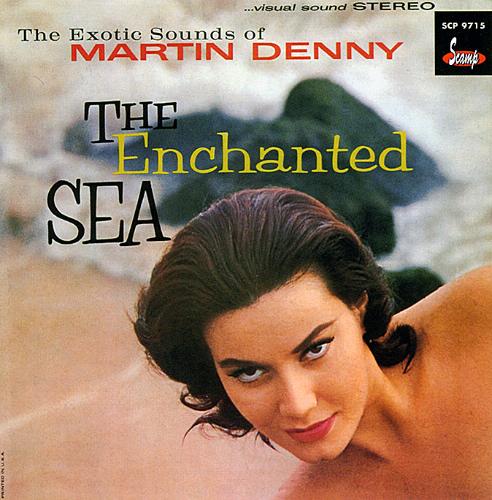
It's hard to explain why I love lounge music so much — it's very silly music played by very professional musicians, background sounds for a vanished world, offering clues to a certain attitude about coolness that seems unrecoverable except in dreams.
Martin Denny more or less invented the Exotica (or Tiki) brand of lounge music in the Fifties. He lived in Hawaii and played this music in a lounge there. It must have made Hawaii seem like a movie set — or more like a movie set. When he recorded the music, his albums swept the nation, making everyone feel as though they were on a Hawaiian movie set.
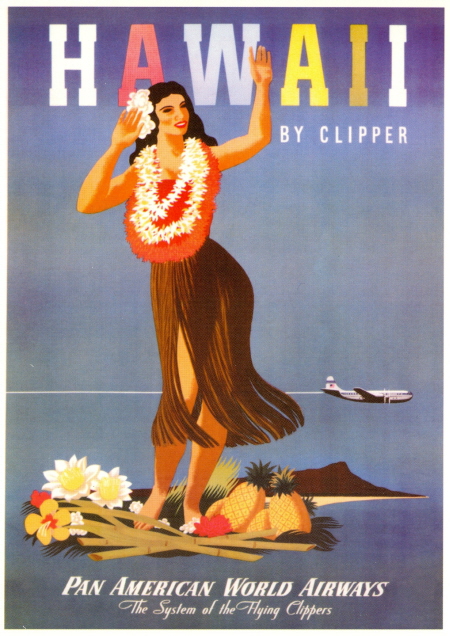
It's early evening, in 1959 — there's a breeze off the ocean, coming in with the sound of the waves. You're in an open-air bar drinking something made with coconut milk and rum, remembering what it felt like, back during “the big one”, to get a little shore leave in Waikiki on your way to the bloody islands further west, in the general direction of Tokyo. Who knew then it would be so bad, requiring something like a miracle just to survive it all in one piece?
A girl is about to walk up to the bar from the beach, wearing a brightly-colored cotton dress, with an orchid in her hair. She's going to be trouble, big trouble — but you can handle it.
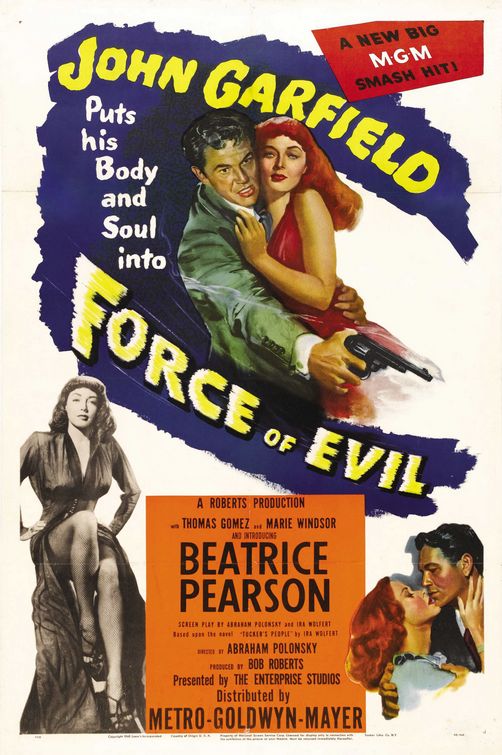
This
extraordinary film is, generically, a late-cycle crime melodrama, but
it's quirky and original enough to transcend the genre pretty
thoroughly. John Garfield plays a crooked Wall Street lawyer who
crosses the line between representing organized crime figures and
collaborating with them. Like the great Warner Brothers gangsters
of the 30s, he's a tough guy on the make who chooses a life of crime,
but he thinks it's going to be “respectable”, white-collar crime — until he's dragged
into the violence and thuggery that underpins the rackets he believes he
can manipulate.
This distinguishes him from the gangsters of the 30s, gives him a kind
of innocence, though it's innocence of a curious sort. He and a number of
the film's characters make a distinction in their minds between
“honest”, harmless criminality, mere corruption, and the “evil”
criminality of men who resort to violence. This takes us very
close to the territory of the true film noir, where all of society has lost its moral bearings, where the lines between right and wrong have been hopelessly obscured.
Abraham Polonsky, who directed and co-wrote the film, is not quite venturing into that territory, however. His outlook is more political — less concerned with moral bewilderment and confusion than with the wholesale structural corruption
of American society.
The lines between good and bad are ultimately very clear in Polonsky's universe,
and he posits off-screen forces that are gathering to fight the
corruption of the system, forces which Garfield's character will eventually decide to join.
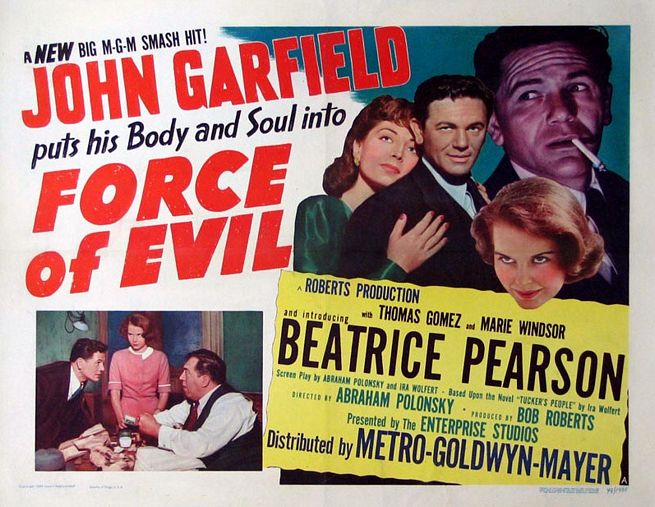
The protagonist of a true film noir
never has this route out of his predicament. His plight has more to do with
existential uncertainty than with political or social problems in
need of practical reform. At the same time, though, Force Of Evil is
suffused with the atmosphere of a true noir,
since the forces of good are never personified dramatically — the
crusading special prosecutor Garfield finally turns to never appears on
screen.
Force Of Evil points the way to Coppola's Godfather films, which, like this one, are in the gangster tradition but with a crucial twist — they concentrate not on the
battle between good guys and bad guys but on the creeping moral decay of the bad
guys, seen from their point of view.
We don't revel in the
transgressive behavior of Garfield's character, or of Michael Corleone
in the Godfather films, as we
reveled in the transgressive behavior of Cagney's bad guys, in
confident expectation that they will be brought to justice in the end. Garfield's character in Force Of Evil,
like Michael Corleone, is punished by forces within himself and close
to home. Far from going down in a blaze of outlaw glory, he rots
from the inside, slowly. Polonsky offers Garfield's character a
way out, through social action and personal reform — Coppola, less
political, less didactic, less optimistic perhaps about American society, offers Michael Corleone nothing.
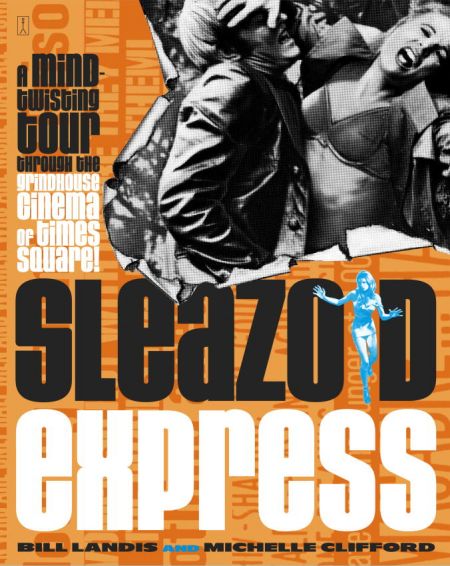
Over on Illusion Travels By Streetcar, Tom Sutpen has posted a poetic tribute to the book Sleazoid Express, which summons back the long-gone days of pre-Disney 42nd Street in Manhattan, when former legit theaters which had become grind movie houses showed exploitation films to the hustlers and grifters who called that part of town home.
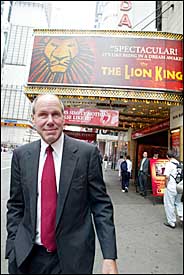
As it happens, I was just watching an interview with Michael Eisner about Disney's decision to refurbish the New Amsterdam Theater on 42nd street, which had fallen below even grind-house standards. Its grand interior, which once housed the Ziegfeld Follies, was open to the elements and home only to birds. Eisner describes telling Rudolph Giuliani, then the mayor of New York, of his fears that family audiences might not feel comfortable visiting that part of town, with its grind houses, sex shops and massage parlors. “They will be gone,” said Giuliani.
“They can't just 'be gone',” Eisner said. “I mean, you've got the ACLU, free speech.” “Look in my eyes,” Giuliani said, and repeated, “they will be gone.”
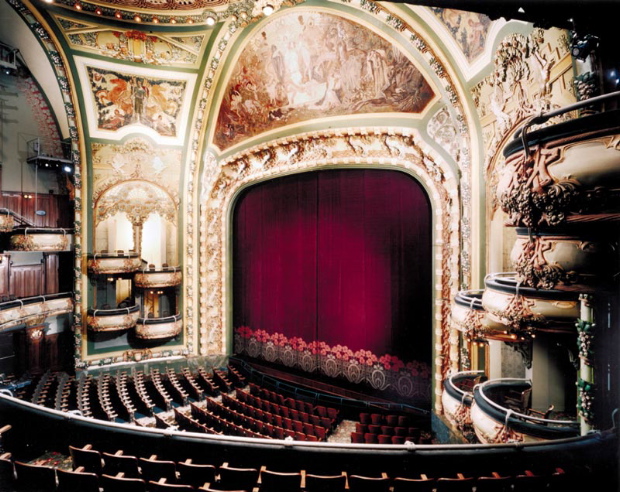
By the time The Lion King opened in the beautifully restored New Amsterdam, they were gone. Sleazoid Express is about what was swept away to make room for Simba and company.
Sutpen suggests why we should remember this lost world, which is why we should remember all the “unexamined” aspects of our culture — because they often provide greater insight into who we really are than cultural manifestations which have the full support of city police departments.
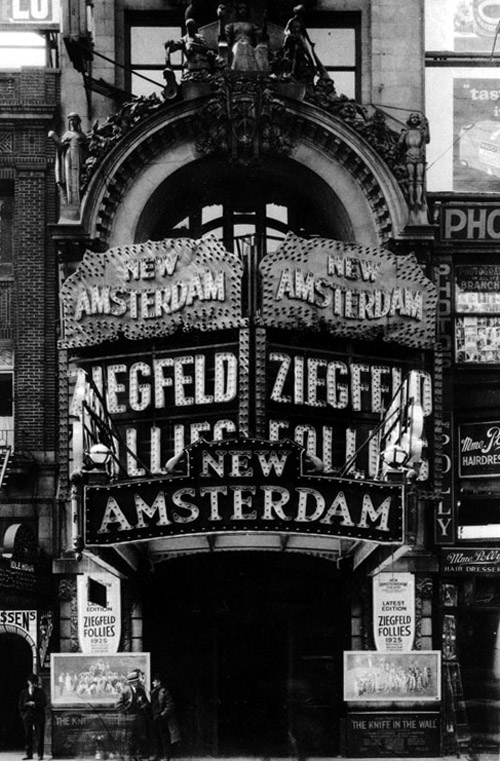
Back in 1908, when 42nd Street was an upscale theatrical Mecca, nickelodeons, the grind houses of their day, were showing the first films of D. W. Griffith. In sleazy dives on the shabbier side streets you could hear “Negro music”, the precursor to jazz. In other words, there was a time when the two great art forms of the 20th Century were part of America's marginal culture, its unexamined culture.
Whatever the exploitation films of the Sixties and Seventies represented, it was important, and it isn't gone. By the same token, as Sutpen notes, the Times Square Renaissance, which turned a scary part of town into a family-safe part of town, also began a process by which Manhattan has been transformed into a mall-like environment for tourists, losing its urban juice and spirit. What began as a rebirth in Times Square inaugurated a kind of lingering death for one of the world's great cities.
Culture, too, has its own circle of life.
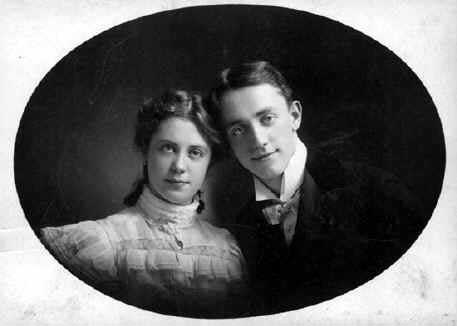
George M. and his sister Josie, when they were, with their parents, part of The Four Cohans, a family vaudeville act, before George became the King Of Broadway.
Josie later married the silent film director Fred Niblo. Josie died of heart disease at a relatively young age, in 1916, the year Niblo entered movies as an actor and director. He's best known for directing the silent version of Ben-Hur, but a film he made a year later with Garbo, The Temptress, is probably his best work.
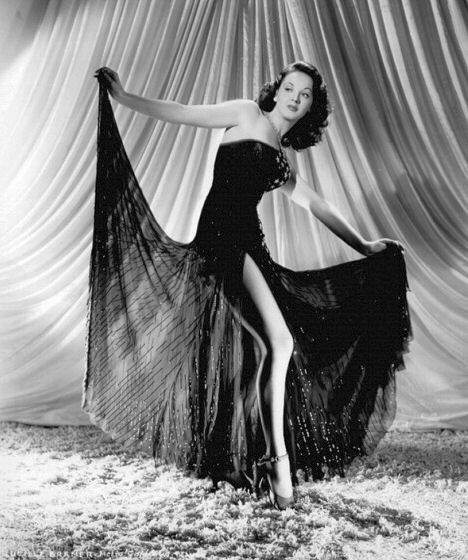
She gained movie immortality in her first film, playing Rose Smith, Judy Garland's older sister, in Meet Me In St. Louis. The next year she danced with Fred Astaire in Yolanda and the Thief, and when that film proved to be a flop, her career took a precipitous downward turn.

She danced with Astaire again in the movie musical revue Ziegfeld Follies, adorned the cover of Life magazine in 1946 and had a supporting role in Till the Clouds Roll By the same year, but MGM gave up on her after that, loaning her out to poverty-row studios for parts in negligible films.
She threw in the towel soon afterward, married the son of a former President of Mexico and went to live with him in La Paz, Baja California, until their divorce in 1963.
Bremer had been a Rockette and a Broadway chorus girl before moving to Los Angeles. She was spotted by Arthur Freed dancing in a show at the Versailles nightclub, given a screen test and almost immediately cast in Meet Me In St. Louis, which Freed produced. She is often referred to as a “protégée” of Freed, and one of Judy Garland's biographers says she was sleeping with him, which might account for her meteoric rise at MGM. I hate to think of her sleeping with Freed, a married man, while they were making Meet Me In St. Louis, that heartfelt paean to family values, but Hollywood is Hollywood.
I don't know what accounted for her meteoric fall. She was a good actress and a talented dancer, but I wouldn't say she had star quality, and in Till the Clouds Roll By she sometimes looks haggard, worn out at 29. Of course Garland was burnt out at an even younger age — MGM had that effect on some people.

It's a strange and sad tale, except for the part about La Paz, one of my favorite places on earth. I like to think of Rose Smith strolling along the malecón there, of an evening, enjoying the breeze off the Mar de Cortes, far from the intrigues of Culver City.
[Image above © 2007 Harry Rossi]
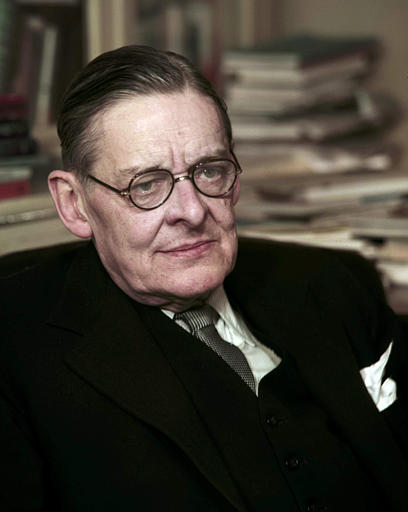
. . . damnation itself is an immediate form of salvation — of salvation from
the ennui of modern life, because it at last gives some significance to
living.
This comes via Tony D'Ambra and his films noir web site. Its application to film noir is perhaps obvious, but it has a profound relevance to the modern age in general. Without knowing the quote, I wrote something similar in a previous post on this site, WHORES: A VALENTINE'S DAY MEDITATION, about Baudelaire's obsession with prostitutes. Eliot's observation comes from an essay on Baudelaire and it sheds a terrifying light on many otherwise baffling phenomena of our time. It explains why middle-class American teens sometimes go ballistic and murder their schoolmates, then kill themselves. It explains why hopeless Palestinian kids strap on bombs and martyr themselves in order to kill Israeli civilians.
Our culture values survival and comfort above all other considerations, and denies the horrifying truth that life without meaning, without transcendent purpose, is worse than death. Anything that promises meaning, even if it's the meaning inherent in damnation, or in a spectacular pursuit of oblivion, is better than a life spent, as Blake puts it, “wailing on the margin of non-entity.”
Tristan, on his blog the emotional blackmailers handbook, recently posted the above painting by Winslow Homer, Summer Night, which I was happy to be reminded of. There's something mysterious and wonderful about the image — two girls dancing together, by the sea, in the light of the moon. It's not quite erotic, but there are tidal forces at work here which might easily lure a lost mariner to his doom, if he didn't have all his wits about him, crossing the bar.
Check out Tristan's site, which usually contains photographs of lovely, gracious things in and around London. It's like a visit to a fine old pub, where you can knock back a pint of Guinness in a corner by yourself and mull over visions like the one above . . . at a safe distance. In that corner, starting on your second pint, you might call to mind, if you've been wise enough to memorize it, this poem by Tennyson:
Sunset and evening star,
And one clear call for me!
And may there be no moaning of the bar,
When I put out to sea,
But such a tide as moving seems asleep,
Too full for sound and foam,
When that which drew from out the boundless deep
Turns again home.
Twilight and evening bell,
And after that the dark!
And may there be no sadness of farewell,
When I embark;
For though from out our bourne of Time and Place
The flood may bear me far,
I hope to see my Pilot face to face
When I have crossed the bar.
In the whole history of cinema there is no greater feast for the eye than Raoul Walsh's The Big Trail, from 1930. It cost something approaching $100 million in today's dollars — though in truth it probably couldn't be made today, without CGI, for less than $300 million — and Walsh put all of the budget on screen, creating an epic vision of a wagon train's journey from the banks of the Mississippi to the Pacific coast. It was shot in a standard 35mm format and in a 65mm wide-screen version, which has recently become available on DVD for the first time.
Because so few theaters were willing or able to refit to show the 65mm version, and because the film was not a hit, Hollywood abandoned the wide-screen format until the 1950s, when it was taken up again in response to the threat from television. So The Big Trail remained a costly experiment gone awry — but it hardly plays as an experimental work today. Walsh's composition for the wide screen is as elegant and accomplished as any in the later history of the format — it bears favorable comparison with the best wide-screen work of John Ford or David Lean.
As a film shot almost entirely on location, it also bears comparison with Greed and Ford's The Iron Horse for its pictorial realism, which is downright breathtaking.
That's the good news. The bad news is that the script for this early talkie is marred by stilted dialogue delivered in a stilted style by almost all the actors, including John Wayne in his first starring role. The location sound is extremely impressive for a film from 1930, but not impressive enough to hold its own with the stunning visuals.
I can say without hesitation, however, that if The Big Trail had been a silent film, it would today be ranked among the greatest movies ever made. If you can look past its limitations as a talkie, you can see the masterpiece it might have been — the masterpiece that on one level it certainly is.
Ford, who discovered Wayne, is said to have held a grudge against him for making his starring debut in another director's film. I suspect, however, that this was in part displaced resentment against Walsh for creating such magnificent images of the American West, which rivaled and sometimes surpassed those Ford had created in his own silent Westerns. It is perhaps no accident that Ford abandoned Westerns entirely during most of the 1930s, returning to the form only in 1939, with Stagecoach . . . and I'm tempted to suggest that Ford spent the rest of his career as a maker of Westerns trying (successfully) to live up to the visual poetry of Walsh's The Big Trail.
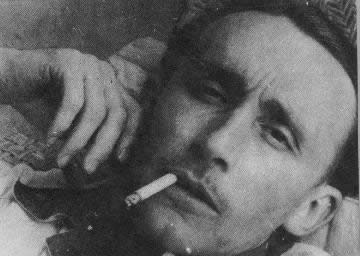
Follow this link for the seventh in a series of essays in honor of André Bazin . . .

This is the seventh in a series of essays in honor of André Bazin . . .
In an article on film and painting, André Bazin argues that the frame around a painting has the purpose of cutting it off from the real world, establishing the limits of a conceptual field necessary to analyzing the painting in its own terms . . . while the frame around a cinematic image is not a boundary marker but merely a masking device, blocking out an infinite expanse of space which we are meant to imagine as existing outside the mask.
This doesn't seem quite right to me. There are certain kinds of painting which evoke the world with an optical integrity, an über-photographic reality, which make it not only possible but desirable to imagine a universe beyond their frames. Much Victorian academic painting has this nature — it was a quality of painting which modernism rejected but which still had its virtues. Some “classical” painters used this quality — Vermeer, for example. The conceptual universe of Vermeer's paintings does not end at the edges of his frames.
And the frame of a cinematic image is often much more than a mask — a device for focusing attention. It sets the boundaries for creating a drama of space, exactly as the proscenium arch does in classical ballet. The distance or nearness of two dancers in a ballet only has dramatic meaning in relation to the space defined by the proscenium arch. In ballet, the frame of this arch doesn't just demarcate an arena of theatrical illusion — distancing it from the real world inhabited by the spectator — it has a functional role in defining the expressive terms of the dance.
It's true that in photographed cinema, as opposed to animation, say, we can readily imagine a world beyond the frame with the same ontology as the actual objects photographed within the frame, but there is a counter impulse to discount this peripheral world in order to read the space within the frame as a theatrical arena whose dramatic content only makes sense within that frame.
Take the scene in The Searchers, for example, when Debbie appears in the far distance on top of a ridge behind Nathan and slowly moves towards and into the foreground space they occupy. This becomes a visceral objective correlative to Nathan's dawning acceptance of Debbie as an individual human being, not just a symbol of his sense of disenfranchisement as a man, an object for the vengeance he wants to visit on life.
The shot is an image of a real place in a real moment of time, but we cannot imagine the world beyond its frame, we cannot imagine the space as seen from Debbie's perspective, for example, and still experience the full meaning of the shot. The frame here acts as a frame does with most paintings — it creates a conceptual field distinct from the world beyond its borders, and only within that conceptual field does the shot “work”.
Bazin's formula is just too simple. In the paintings Alma-Tadema did of the ancient world, we feel that the frame is indeed just a mask — a window onto a whole lost world beyond its frame which we delight in imagining. And conversely, when we are swept into the space of a great animated cartoon, it's hardly necessary to seriously imagine a whole cartoon universe beyond its frame.
We can imagine such a universe beyond the cartoon frame, just as we can, with much less effort, imagine a world beyond the ridge Debbie appears on, but it's the way the frame limits such images, takes them out of the larger world, that makes their meaning in purely cinematic terms possible.
Here again, I think it's Bazin's location of cinema's power in photographed reality, rather than in the drama of space, that leads him to a deficient theoretical proposition.
Amy Crehore is showing her stuff in two art exhibitions opening next week, one in Las Vegas at the Hardrock Hotel & Casino starting tomorrow and running for two days and one in Brooklyn at the Ad Hoc Art gallery starting on the 25th and running through August 24th .
An image from the Brooklyn show is seen above, one from the Las Vegas show below:
If you're wandering around either of these two cities in the days ahead, drunk, heartsick, sorry about the whole thing, wondering where it all went wrong, try an art pick-me-up — good for what ails you. Here are the details:
“CRIMES ON CANVAS” at HARDROCK HOTEL & CASINO
HUGE Art Exhibition in Las Vegas
Friday, July 18th – 7pm to Midnight
& Sat. July 19th – 1:00pm to Midnight
Curated by m modern Gallery
Free & Open to the Public!
And . . . clear across the country, practically . . .
“5 IDENTITIES, 5 DESTINATIONS” at AD HOC ART
49 Bogart Street, Brooklyn, NY
718-366-2466
Opening July 25, 2008 from 7-10pm
Gallery hours Wed-Sunday 1-8pm
Crehore will attend the Brooklyn opening.
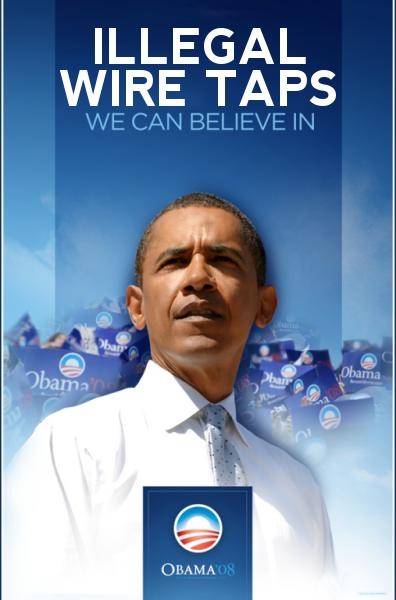
I'm still having a hard time believing that Barack Obama actually voted with the Bush administration to cripple the Fourth Amendment to the Constitution, much less understanding why he would do such a thing. I know he's got a lot of very intelligent advisers. Did they identify a large group of swing voters who would be more inclined to support Obama knowing he was willing to trash the Constitution in order to create a false sense of security about terrorism? Was it larger than the group of committed supporters, like myself, whose support would be catastrophically undermined by the vote?
I made a very small contribution to Obama's campaign — the first time I've ever done such a thing. I feel now as though I was played for a sucker. I certainly won't be sending the guy any more cash. More than that, I want my money back. It's no wonder that Obama's fund-raising efforts have been redirected recently towards more traditional big-money donors. The little guys like me who got him where he is today weren't looking to finance an attack on the Bill of Rights. Maybe the fat cats will be less finicky about such things.
I can understand taking a “nuanced position” with respect to abortion, or gun rights, or the timetable of withdrawal from Iraq, because these are genuinely complex issue, but is it possible to take a “nuanced position” on the Fourth Amendment, one of the keystones of the American system — a “balanced positioned” somewhere between enforcing the amendment and abolishing it altogether? I don't think so. A watered-down Bill of Rights isn't a bill of rights at all — it's just a meaningless expression of good intentions.
This is all made even more mysterious by the fact that Obama had previously vowed to support a filibuster against any bill granting immunity to the telecoms for violating the Fourth Amendment. When such a bill came before the Senate he couldn't even bring himself to vote against it, as so many other Democratic Senators did.
The only conclusion I can come to is that Obama is a true Democrat, a true American progressive. He's committed, unconsciously at least, to losing. The American Left is all about losing. It enjoys complaint and grievance — it has no ambition to govern.
What else could explain the Democratic Party's effort to nominate Hillary Clinton in place of Obama? What else could explain the Clinton campaign's decision to play the race card repeatedly, in an effort to divide the electorate, and to continue with this tactic long after it was clear that Hillary wasn't going to win the nomination? What else could explain Jeremiah Wright's efforts to derail Obama's quest to become the first African-American President, or Jesse Jackson's bitter animosity towards Obama?

Indeed, what else could explain the odd cover recently published by The New Yorker, a leftward-leaning publication? Masquerading as satire, it merely sent an image out into the culture around which irrational suspicions of Obama could coalesce.
The truth is that the American Left is terrified that Obama might actually win this election, violating the only enduring image it has of itself — that of self-righteous loser. Obama, far from transcending outdated images like this, seems to be buying into them. My guess is that the vote to undermine the Fourth Amendment won't be his last effort to alienate his most passionate supporters, the only way he can lose a contest whose outcome ought to be a foregone conclusion by now.
You just can't underestimate the American Left's lust for failure.
Hello, kitty.
By Al Moore for Esquire . . .
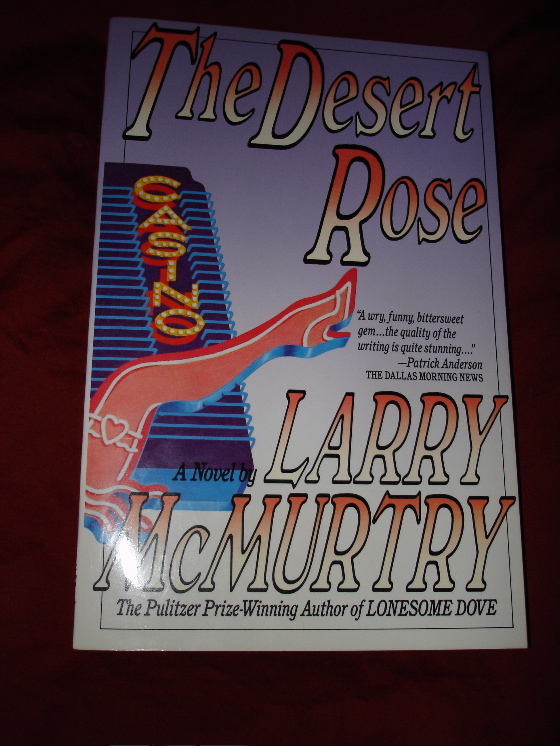
Larry
McMurtry's Lonesome Dove is one of the great American novels. He took
three weeks off from writing it to pen The Desert Rose, which is a
fine novel in its own right, and one of the best ever written about Las
Vegas. Set in the 80s, when Vegas was a little down on its luck, it's
the story of a showgirl coming to the end of her career as her teenage
daughter starts one, as a dancer in the casino where her mother works.
It captures the melancholy laced with enchantment that can overtake
people who actually live and work in this strange town — the
good-natured sadness you often see in the eyes of older cocktail
waitresses . . . in their relentless hopefulness that you're not going
to be a jerk.
There
are only a couple of revues left in town which feature showgirls like
Harmony, the novel's protagonist, but the type of woman who is
basically paid to be beautiful remains — and the town has its share of
girls like her daughter Pepper, whom the system has robbed of joy and
compassion.
In
Harmony, McMurtry creates a character whose only strength is optimism,
but he grants her the grandeur of that strength, without condescension.
She's a wondrous creation — as heroic in her way as any of the
legendary frontiersmen of his period fiction.
The
Desert Rose is period fiction itself now, twenty years on, but the
feel of the city hasn't changed all that much — it still takes courage
to find real joy amidst the ruthless merriment of it all . . . and
women like Harmony are still the key to everything.